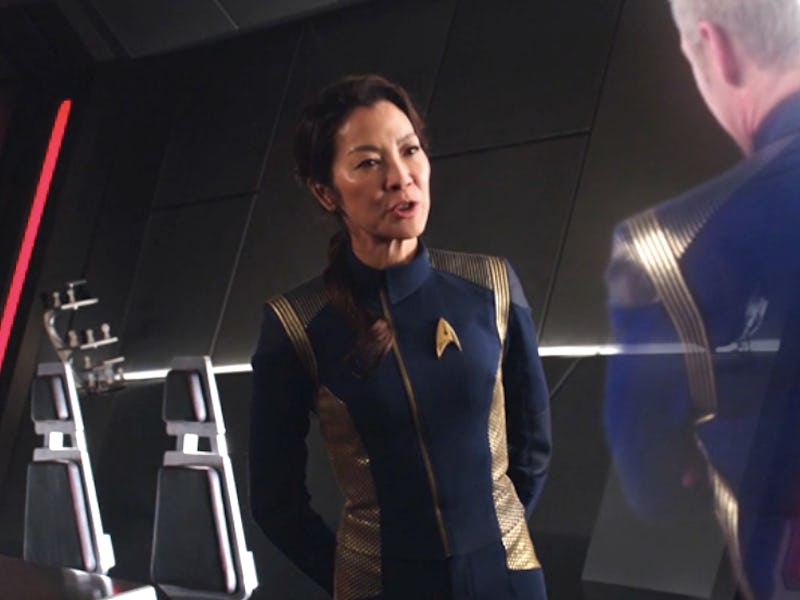‘Star Trek: Discovery’ Canon: 5 Changes to the Timeline
Retcon, warp factor 10!

Boldly going into a timeline where some starships have gone before is part of the tightrope Star Trek: Discovery has to gingerly walk. Because it’s technically set in the 2250s, that puts it only a decade before the halcyon days of Kirk, Spock and Bones. And, though the show may have answers for why all this canon feels different, that doesn’t change the fact that on some fundamental level, every minute of Discovery is a retcon. So far, that hasn’t hurt the quality of the show one iota, but for the curious, there are some very specific ways the history of Star Trek’s future has been altered. Here are five big retcons Discovery has made to the universe of Star Trek.
5. Starfleet’s “Look”
Though David Mack’s new book Desperate Hours effectively reconciles all the aesthetic differences between “The Cage” era of Trek and Discovery, the introduction of the all-blue jumpsuit uniforms is a new wrinkle in the history of the 23rd century. Desperate Hours does this by asserting that different styles of starships and uniforms were being used by Starfleet at the exact same time. Still, that doesn’t change the fact that uniforms, phasers, and tech on both the Shenzhou and the Discovery are brand new to the canon, to say nothing of Starfleet’s sudden love of Star Wars-style holograms over good old-fashioned viewscreens.
4. Klingons Have a Cloaking Device Early
In “Battle at the Binary Stars” T’Kuvma uses an “invisibility cloak” that devastates the USS Eurpoa. But, in old Trek canon, the Klingons got cloaking technology from the Romulans sometime in the 2260s. In fact, this swap of technology resulted in the Romulans using Klingon-style warships in exchange for the cloaking tech. T’Kuvma’s cloaking device also seems really, really advanced and a lot more similar to the phase-cloaking technology from the 24th century in which you can not only make your ship invisible but also basically teleport the whole thing into other ships. This tech was considered illegal in The Next Generation episode “The Pegasus.” Obviously, the Klingons look way different, too. But a lot has been said about that already.
3. Tribbles That Don’t Reproduce Like Crazy
Captain Lorca has one, lone tiny Tribble in his ready room on the Discovery. Why this Tribble hasn’t reproduced like crazy already is anyone’s guess. Plus, the Starfleet crew of the Enterprise didn’t seem to know anything about Tribbles in “The Trouble With Tribbles.” Perhaps whatever Lorca is doing with the Tribble is top secret, which makes sense, considering the fluffy balls are considered an enemy of the Klingon Empire.
2. Sarek’s Other Child
Obviously, the biggest change in Star Trek canon is Discovery’s main character; Michael Burnham herself. Raised by Spock’s parents — Sarek and Amanda — Burnham is kind of like a human version of Spock. Instead of struggling to repress her humanity, she’s constantly figuring out how to embrace it, despite being encouraged to act like a Vulcan. In fairness, this canon change isn’t that big of deal. Spock had a secret half-brother named Sybok in Star Trek V: The Final Frontier. And that dude had a giant beard, laughed constantly, and always wanted you to talk about your feelings.
1. Far-Out Instantaneous Propulsion System That Runs on Fungus
In the third episode of Star Trek: Discovery, its is revealed that the Discovery is testing a new organic drive system that would allow them to cover huge distances in a blink of an eye. Obviously, this technology has never been glimpsed in Star Trek before, and if it had, it would have fixed several, several problems. For one thing, the entire premise of Star Trek: Voyager is based on the idea that their warp technology can’t get them home for nearly eighty years. For lseven seasons, the USS Voyager tried to come up with cockamamy stuff like this to get them home faster. They failed every time, except for the last time, in the last episode. This was pretty much 100 years after the events of Discovery. So, this these new experiments are either a success and kept secret for some reason. Or a huge failure. Based on what happened to the USS Glenn in the third episode, most fans are betting on the latter.
Star Trek: Discovery airs on Sundays at 8:30 p.m. Eastern on CBS All Access. And because Harry Mudd is coming soon, Trek canon will keep getting more complicated.
If you liked this article, check out this video on Inverse’s review of Star Trek: Discovery.